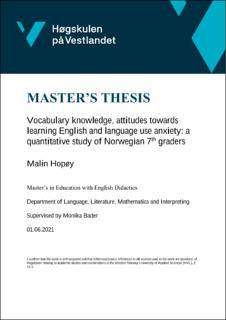Vocabulary knowledge, attitudes towards learning English and language use anxiety: a quantitative study of Norwegian 7th graders
Master thesis

Åpne
Permanent lenke
https://hdl.handle.net/11250/2770339Utgivelsesdato
2021Metadata
Vis full innførselSamlinger
Sammendrag
This research study investigates Norwegian 7th graders’ vocabulary knowledge and to the extent to which it correlates with attitudes towards learning English and language use anxiety. Additionally, this study aims to investigate in what way a collaborative output task can affect the pupils’ vocabulary knowledge. The study was based on data collected from 74 Norwegian pupils of English in 7th grade over a period of two weeks. A two-group quasi-experimental study was implemented to investigate the effect of a collaborative output task, in the form of a classroom debate. The control group had regular English lessons, while the experimental group participated in a classroom debate project. The pupils were testes twice, where the pre-tests provided information of the pupils’ vocabulary knowledge, attitudes towards learning English and language use anxiety. Whereas the post-tests were used to compare results with the pre-test scores in order to investigate a potential effect of the collaborative output task. The tests consisted of a vocabulary level test and an attitude/anxiety survey. The vocabulary level test measured vocabulary frequency levels. Level 1.000 and 2.000 represent the high-frequency words (around 90% coverage of running words), and level 3.000 represent some of the midfrequency words (Nation, 2013). Considering the coverage of the high-frequency words, it is important that learners of English gain knowledge of at least these levels (Nation, 2013). The value of the test is that it indicates which word frequency learners should focus on.
Results from this study showed that the pupils’ vocabulary scores decreased for each level. It also showed that overall the pupils had positive attitudes towards learning English and slightly low levels of language use anxiety. Additionally, the results showed a significant, negative correlation, between both vocabulary knowledge and language use anxiety (p < .001) and between language learning attitudes and language use anxiety (p < .05). This indicates that the pupils who had low language use anxiety, had high vocabulary knowledge and positive language learning attitudes, and vice versa. No statistically significant correlation was found between language learning attitudes and vocabulary knowledge (p > .05).
However, the main finding was the vast variation in pupils’ vocabulary scores where some pupils did not master level 1.000, while others mastered level 3.000. This suggests that some pupils will only be able to use survival vocabulary for traveling, while others should be able to read unsimplified text with the help of a dictionary and converse in English. These variations are major; therefore, this thesis stress the importance of teachers assessing their learners’ vocabulary knowledge. Once the teachers know their learners’ vocabulary knowledge, they can adjust the teaching and the materials to the different frequency levels so that the pupils can keep increasing their vocabulary knowledge through their education.
Beskrivelse
Master’s in Education with English Didactics
Department of Language, Literature, Mathematics and Interpreting
